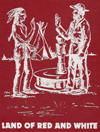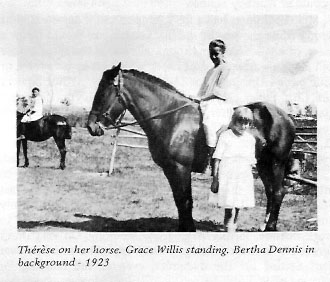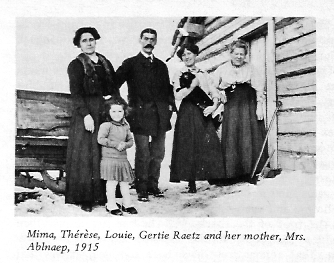 THERESE RECALLS
THERESE RECALLS
I, Thórese (de Delley) Craige, was born in Tyrol, Alberta. It was later named Mooswa, then changed to Lindbergh, named after Col. Lindbergh, aviator. I can just remember, in about 1917 or '18, being at Whitney Lake School. The only pupils I can remember are the John Heins children; Leonard, the eldest, Reuben, two girls and a younger son, Walter. Mother walked with me a few times to school, arriving at the forenoon recess, staying till 3:30 p.m. then walking back home with Wayne Evans, second son of E.T. Evans. He was a real chatterbox. Miss Vina McKenzie, from south of the river, was my first teacher. Rolf and Archie Anderson rode horseback to school and Rolf told me just last year that I rode behind him a few times, but I can't remember bouncing along behind him on "Old Whitey."
In the spring of 1919 we moved to Dewberry, returning to Mooswa July 1, 1922, to the old homestead on S.W. 30- 56-4-W4th. Mr. Roy Baker from Calgary was teacher at Whitney at that time. He was just a five month, summer teacher. That year I was in Grade IV and there were eleven pupils, the largest class until I reached Grade VIII. Mr. Baker boarded at Art Gordon's and rode a bicycle. In May 1923 he returned again. To the dismay of all the class, he told us we would all have to repeat our grade; said we had not learned enough last year.


He was very interested in his butterfly and bug collection; had the pupils catching insects for him. A large Monarch butterfly centered the collection with smaller butterflies set outwards. All were imbedded in white cotton batting, named and enclosed in a big glass-covered case of about 12 x 20 inches. The bugs and beetles were in a big glass-covered box about 20 x 20 inches square. Each one was pinned about an inch from the bottom of the box and arranged, largest again in center, small to the outside, and each one named.
In 1924 our teacher was Mr. Harry McKeen from Prince Edward Island, also a summer teacher. Two of his friends who came west with him, Mr. and Mrs. Dean Colpitts, taught at Martin and Norway Valley schools. Mr. McKeen rented a newly broke colt from Leonard Coombe, and staked the pony at Coombe's in the day time. Many a time the colt did not want to leave his old home in the evening; McKeen was no horseman.
His first morning at school, teacher went to the pump and tasted the water, found it drinkable, then called out for someone to bring him a water "pile". The children paid no attention to him with his English accent, but I had heard enough of the English accent to understand, and fetched him the "pile". I was the oldest in school, and teacher, not knowing what was required as to timetables I had to make one. I believe I had ringing ears for some time to come.
Miss Hattie Markstad of Elk Point was our teacher for seven months but I don't think she quite finished the term. There was an early snow and with drifted roads and cold weather it was necessary to close the school. We baked potatoes in the big pot-bellied heater. We tossed big potatoes on the red coals. The taters were usually burnt but if we put in large ones at forenoon recess, they were ready to eat at noon. Eaten with butter and salt, they tasted real good.
Mrs. Todhunter, British Columbia, taught us in 1926. She had a seven year old son and they boarded with the Coombe family. She had taught me for only four months when I went to Edmonton to the Sacred Heart School for three months. I boarded at my aunt's as my cousin attended the same school. The city schools were more advanced as they had ten months of school compared to our five to seven months. I returned home to struggle along the best I could at Whitney School.
Mrs. Todhunter had a fiery temper, and if anything went wrong while she was at the blackboard, she would throw a piece of chalk across the room, always to the same corner and always a new piece of chalk which broke into three or four pieces. One very hot day, Mr. and Mrs. Arthur Bowtell and Cliff Fuller came by on the way to Lloydminster and asked Mrs. Todhunter to go along. It was noon hour so we got the afternoon off. On very hot days we came to school at 8 a.m., recess was at 10:15, and at 1 p.m. we left for home and dinner which one was good and ready to eat.
Mr. Gilson came to teach in 1927 but I was able to attend for only three months that term which was my last year of school. I had to help on the farm as I was the only child and "jack of all trades and master of none". I had to work outside, mostly haying and stooking. Oh yes! Don't forget all the rock hauling, even to rock blasting. That was fun! Setting off the dynamite, even to the tamping, or packing of it. I also helped with stump blowing which was packing with mud. Messy! If one got too close to the dynamite and breathed the fumes one got a terrible headache. I learned very little housework. Results? A poor cook! I pity my husband, but I guess as the years went by I learned, as so far he has managed to survive for over forty years.
As I think back to bygone years, I remember that, while Mr. Baker was teaching his second term, he trained Arthur and Bill Gordon and I for the school track meet; for standing broad jump, running broad jump, and hop, step and jump. I believe I was the only girl who competed right to the fmals. Jumping in a dress on a rainy day was no fun. Mr. Alex Peterson was one of the judges at Norway Valley School where the track meet was held. In the standing broad jump, Bill beat me by four inches. In hop, step and jump I made twenty-one feet, but no prize.
The track meet was actually a part of the school fair that was held annually for several years at Norway Valley, and schools from surrounding districts participated. There were flowers, vegetables, grain and school work. Gaylord Maxwell of Mooswa School got first prize for a drawing of a map of Canada; I got second. When I drew that map I had to print names of rivers, mountains and cities. That was my first printing, all my schooling was just writing. I entered in the contest of sewing patches on blue and white gingham, and got second prize.
Some of the pupils going to Whitney School from 1922 were: Irene, Nancy and Vina Anderson; Bertha Dennis; Lyndelle Coombe; May Taylor; Bill, Neva, Tom and Jerry Crook; Bill Evans; Arthur, Bill, Claire and Nina Gordon; Steve and Annie Burger; Zora, Ernie and Clifford Woods; Eli, Gladys, Gib and Edward Evans. The last rider out of the school yard after school had to close the gate to keep stray stock out of the yard and that job was usually mine. I had to saddle my pony and cinch her real tight, for I had a pony that loved to shy and toss me into a bush patch or anything. Then she would look at me and start cropping grass, waiting for me to mount up again.
In the spring of 1930, being right in seeding time, Bob Braithwaite, a cattle buyer from Dewberry, could not find riders to drive eleven head of cattle from Art Bowtell's at Mooswa to Dewberry, so Irene Anderson and I took on the job. Leaving at 7 a.m. we crossed the Mooswa Ferry. We got all the cattle on the ferry alright, but there was an unpredictable Shorthorn bull that decided to leave. Right over into the river he jumped, swam back to shore, went back onto the ferry and was a good fellow for the rest of the day. We arrived at Tom Cowley's where a good dinner awaited us, also a good feed for our saddle horses.
Tom and his brother Jack had two big steers that had caused lots of trouble on a previous drive, and they put them into our bunch. We got about two miles from Dewberry when both hit for the tall timber. Irene took after the blue roan and I after the other. We soon gave up and went back to our eleven head and finished our journey to Dewberry, arriving at the stockyards about 7:30 p.m., two very tired, stiff and sore gals. We stabled our horses at Jim Armstrong's and had supper at the restaurant; we stayed overnight at Gus Garnier's. We reached home about 1 p.m. the next day. We received $7.00 each for our trip. As soon as I arrived home I had to take a young team and harrow a newly seeded wheat field. I usually rode saddle horse behind the harrows, but, although my pony and I were about the same age, I was the most spry of the two after that trip so I took pity on my Daisy horse and walked for the rest of the day.
I liked outdoor life such as snow-shoeing and hiking. When I was old enough I had a trapline. First I caught rabbits, then weasels, then muskrats and next coyotes. I preferred shooting rabbits. A box of 22 short shells cost 25¢. Even 25 was scarce in 1925 or 26, but from one box of fifty shells I got forty-nine rabbits which were used to feed to the laying hens, either raw or cooked, also the dog and cats were always hungry for meat. We could not eat the rabbits that year as they had water blisters under the skin and were unfit for food.
I owned two saddle horses. I liked horseback riding and I had my share of it to do. Dad insisted that all the cattle, young and old, be brought home nightly, sometimes not an easy task. Some years we had a good cattle dog which helped. Dad had brought a set of six Swiss cowbells from Switzerland when he came from the old country. Our cows liked these bells and would stand at the gate until the bells were strapped on tight each morning. They could be heard very distinctly for two or more miles.
Some people called this set a carillon; all six chimed and each one was a different size. Each bell had its own tone, harmonizing with the others so that, with the movement of the cows, a melody was formed. Of course the cows moved haphazardly so there was no definite melody. In Switzerland, where grazing land is scarce, several farmers kept their cattle in the same area. Each melody was in a different key and the farmer listened for the special melody that told him the location of his own cattle. The sound was lovely to listen to. Can't you just imagine the music in the mountains as the cattle followed each other down a path, and then diversing in the valley, each group to its respective home? It is a memory not to be forgotten. The poem brings all to mind perfectly. Thank you, Neal.
Of course Dad did not bring out a complete set as it would have been too costly. I do not know how many a complete set would consist of. I feel badly that all his bells are gone. Some were burned in a fire at the St. Paul Foundry where they were taken for repairs; some were broken on rocks by the roadsides, then thrown away; Dad buried one somewhere before he died. There are none of them left in existence today.
We milked about six or eight cows in the summertime. Cream was sometimes taken by the mailman to Kitscoty; later, when the railroad came to Elk Point, then to Lindbergh we took the cream to the station by wagon in the evening after milking time. A five gallon can of cream, grading special and testing from forty-eight to fifty-one percent butterfat, brought $2.35. At least it paid the grocery bill.
One morning in 1926 I saw a runaway team coming from the west. They belonged to the mailman, Louis Sorenson, who lived about four miles north of the present site of the Salt Plant. This was the old team that the previous mail carrier drove, and while Louis was closing a gate the team left him and headed for Kitscoty, perhaps thinking it was mail day. I ran out to our pasture and caught my saddle horse, took a short cut across the open section south, across Middle Creek and out to the Sand Plains. The team was still ahead of me but getting slower. They stopped
at a gate (I think it was closed) on the north side of Steve Borger's farm. I drove the team back to my home and put them in the barn, leaving the democrat out at the gate so Louis would know where his team was. About an hour later Louis came in, driving his young white team hitched to the big wagon with the double wagon box. Ordinarily he used the white team to change off with when the old team needed a rest. Later that day he drove the runaway team on the mail trip which must have used up some of their spare pep. Louis gave me an old American dollar, which I still have, for catching the team. I was offered eight dollars for that coin but did not sell it.
LOUIS DE DELLEY'S BELLS
by Neal Edwards
When the robins chirped in the willows
And the crocus flowers bloomed,
Wild geese were winging northward
In the light of a big round moon.
The muskrat left his winter home
And I heard a lone loon yell,
The sound I enjoyed the most of all
Was the chime of de Delley's bells.
It was springtime in Alberta
And sweet green grass did grow,
Life was awakening thro' the land
Gone was the winter's snow.
The calves played on the hillside
Little chicks broke from their shells,
I knew that summer was almost here
When I heard de Delley's bells.
Imported from a distant land
So far across the sea,
They were so proudly polished
By Louis de Delley.
As the cows went out to pasture
On the morning air there fell,
As sweet as any church chime
The tune of de Delley's bells.
Therà se would saddle her pony
And then would sally forth,
She would listen for the music
East or west or south or north.
When I heard the steady chiming
Night was coming one could tell,
As homeward walked the milk cows
To the rhythm of the bells.


